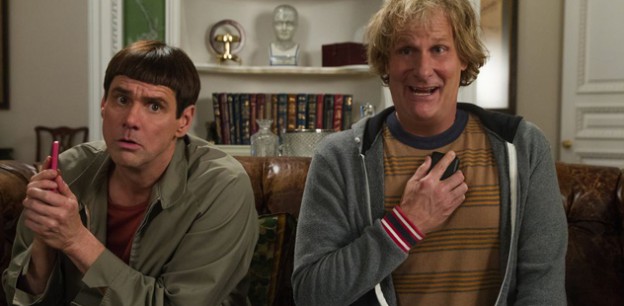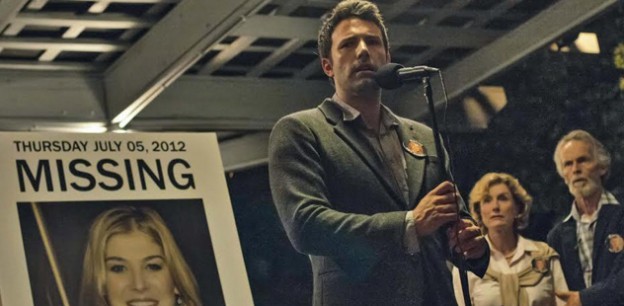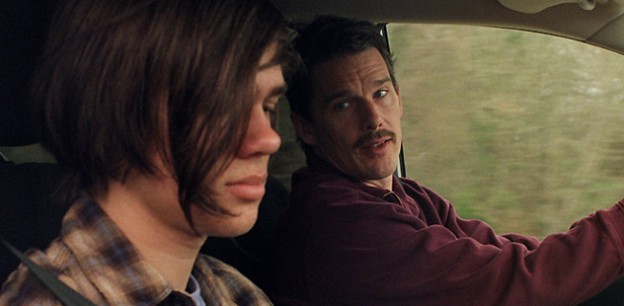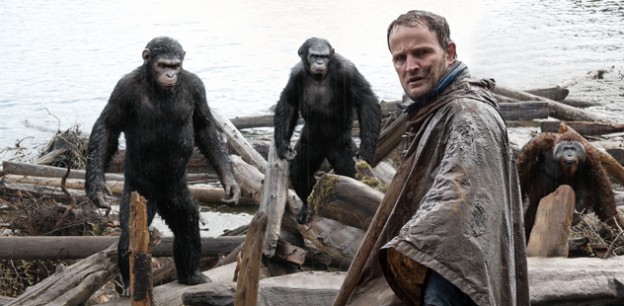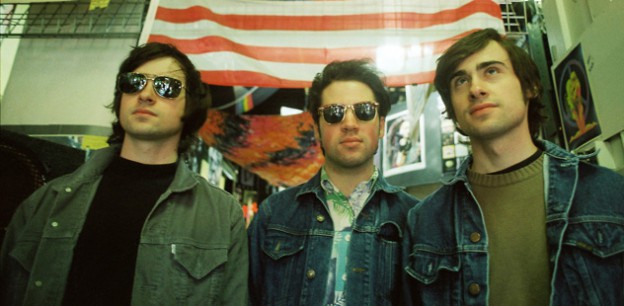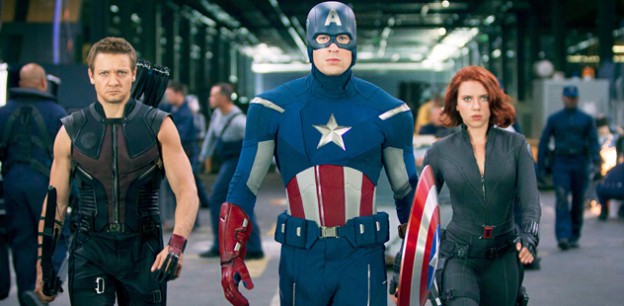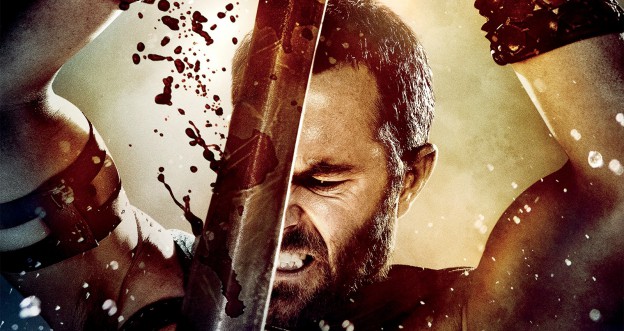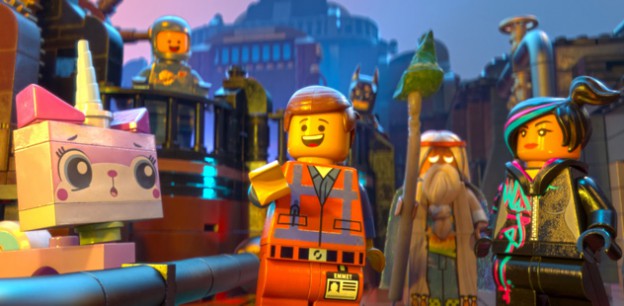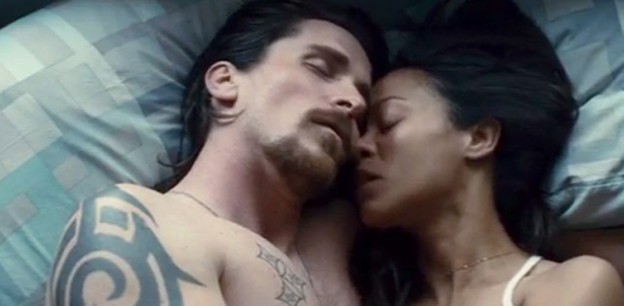Dumb and Dumber To
Rated PG-13 | {0 out of 5 stars}
Leaving the theater Thursday night in a mystified stupor, I had the inkling to drive straight home and go full blown Kerouac on this review, a one-paragraph stream of consciousness devoid of any and all punctuation—just a flurry of frantic observations attempting to explain how something could be so positively putrid even with expectations coming in at a palpable low. But let’s start with some facts.
Fact 1: The Farrelly Brothers haven’t made a decent movie in 14 years.
Fact 2: The Farrelly Brothers have recently peaked in heinousness, their penultimate release being the loathsome Three Stooges.
Fact 3: The first Dumb and Dumber came out 20 years ago, leaving the statute of limitations for releasing a sequel well surpassed.
But of course there is no such statute of limitations. This is Thunderdome, this is ‘Nam, there are no rules. Hence Dumb and Dumber To.
I’m not sure whether my being a loyal fan of the original made me more or less likely to hate this movie. I view Jim Carrey and Jeff Daniel’s 1994 performances as classic; masterful slapstick comedy from lovable idiots, seemingly timeless in nature. I’d go as far as to say that Dumb and Dumber is one of the best comedies of its era, while still relevant to a younger generation of kids. (I learned the latter assertion firsthand while subbing high school during the final week of class, when every period becomes a 45-minute film festival.) Of course the new installment would be incapable of meeting my, or anyone else’s, reverence for the first—especially considering that nobody in the last decade was clamoring for a sequel to begin with—but does that mean it had to be completely rotten? No! And yet, it is.
The basic gist is that 20 years after the misadventure with Mary Swanson, Lloyd (Carrey) is catatonically confined to a wheelchair at a mental care facility, having never recovered from the heartbreak of losing his one true love. Harry (Daniels), devoted friend that he is, still continues to visit Lloyd once a week, and one day announces that he is dying of kidney failure. Lloyd then reveals he’s been faking the entire time, quickly reuniting the pair to track down Harry’s long-lost daughter in the hopes of a familial kidney transplant.
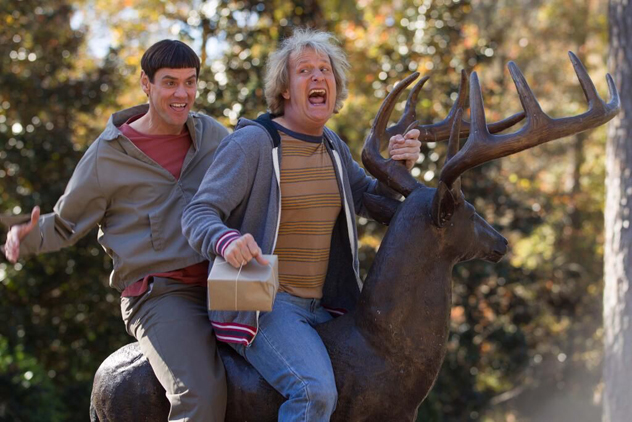
But who really cares about the plot in a movie like this? Just make us laugh. That’s all we ask! What becomes immediately apparent, however, is that this is not the same Lloyd Christmas and Harry Dunne of 1994. As you’ll sometimes notice on a show like Saturday Night Live when a former cast member comes back to host years later, they simply can’t recapture the mood or magic of characters they portrayed in the past. Chris Farley reprising Matt Foley, Dan Aykroyd reprising Irwin Mainway—pick one of a hundred examples. Such is most certainly the case for Carrey and Daniels, who force themselves into the once-familiar roles with the grace of G.G. Allin at a fecal matter peep show.
Blame the writing if you like, because it’s dreadful. Aside from the pathetic and constant recycling of every comedic morsel possible from the original, all the crude-but-cute humor that made the first film so endearing is thrown right out the window. Instead we’re just left with crude, and poorly executed at that. A “me love you longtime” bit mocking Asians? Sure! A menstruation gag replete with the stained white pants of a 12-year-old girl? Why not? Or maybe a fantasy in which Harry instructs Lloyd to “bone” his daughter “like a chicken cutlet.” Bring it on!
Really, I love dick and fart jokes as much as anyone. More than most, even. But Jesus Christ, gimme something to work with here. Tastelessness can be tasteful, but only when it’s actually funny! I mean is this a fucking Artie Lange production, or what? Essentially, if you were to stuff the Dumb and Dumber To synopsis inside a fortune cookie, the (mis)fortune would read something like this: Where Harry and Lloyd were once sweet, blissful morons, they are now obnoxious, perverted assholes.
And there isn’t much else to say. I truly hated this movie. One hour and 40 minutes of insufferable tripe, a complete and total embarrassment. I will always love the Farrelly Brothers for giving us three fabulous comedies over a four-year span of greatness, but they’re an absolute joke at this point, and not in the way they’d like. We’re talking Kevin Smith territory here. And nobody wants to be compared to Kevin Smith. Not even Kevin Smith.
Gone Girl
Rated R {3.5 out of 5 stars}
Yes, that’s really the title of this review. But hear me out.
Three weeks ago I spent $8.50 on a Friday night to see A Walk Among the Tombstones. “Hey,” said I, “it’s Liam Neeson tough-guy shit! What could go wrong?” Little did I realize that Tombstones would amount to nothing more than an embarrassing piece of misogynistic torture trash, poorly acted, directed and adapted. It was the kind of cliche, pseudo-noir rubbish that makes Nicolas Cage’s 8MM look like Citizen Kane. And all I can really do about it is sit and ponder the hows and whys of a movie whose sole purpose is showcasing ultra-violence against women. Therefore I spent the first portion of Gone Girl expecting to be upset.
I suppose that isn’t fair, though, to expect a David Fincher thriller to stoop to such ignoble levels, but conditioning is what it is. Gone Girl is not a gratuitous horror show. It’s actually a clever and detailed murder mystery, written and adapted by author Gillian Flynn, that uses unsettling themes and personalities to its tasteful advantage.
Without giving too much away, Gone Girl is the story of Nick and Amy Dunne (Ben Affleck and Rosamund Pike, respectively): an unhappily married couple detached from their once-elite Manhattan lifestyle. Having moved to Nick’s boyhood home of Missouri to care for his now-deceased mother, their marriage has since become a sham with divorce looming on the horizon. But when blonde and beautiful “Amazing” Amy mysteriously vanishes from their suburban mansion one morning, the ensuing investigation begins to point dirty fingers at Nick—all of which lead straight down an impossible rabbit hole of cold and calculating cruelty, emboldened by a national media frenzy.
The surrounding cast is a strong one. Nick’s twin and often incredulous sister, Margo, is aptly played by Carrie Coon (whom you may now recognize as Nora from The Leftovers); detective Rhonda Boney is Kim Dickens (The Zero Effect, Deadwood); bona fide weirdo Desi Collings is the lovable Neil Patrick Harris (he’ll always be Doogie Howser to me); and in perhaps the surprise performance of the film, Tyler Perry expertly plays celebrity lawyer Tanner Bolt.
While I won’t leap to compare Gone Girl to Fincher’s most brilliant directorial works like Seven, The Game or Fight Club, this is a smart film, touching a variety of nerves along the way. Much of the credit indeed belongs to author Gillian Flynn for penning both the script and book, but it takes the right vision to ultimately project page to screen, and Fincher was certainly up to the task. Themes of infidelity and jealousy are paramount, often causing a near visceral reaction as Fincher weaves the twists and turns in a manner that causes one to reevaluate character preconceptions along the way. To get that much out of Ben Affleck, for example, is noteworthy in its own right, as Affleck the actor can be so terribly uninteresting so very, very frequently. (A needless aside: During my initial perceived frustration with the film, I found myself internally cursing Affleck for once again casting himself as lead in a movie he directed, despite consciously knowing he wasn’t the director. Ben Affleck can have that effect on people, you know.)
Gone Girl’s imperfections stem from sheer plot density—there’s a lot going on pretty much all the time. You’d think that 149 minutes would be more than enough to properly attend to each thread and character, but that isn’t the case. Take Tyler Perry, for one: His portrayal of celeb attorney Tanner Bolt is arguably the best in the entire film, and yet he’s barely in it. The same can be said for Neil Patrick Harris, who deftly plays a freakish oddball you’d love to know much more about, yet we learn virtually nothing. Which doesn’t imply that most other aspects of Gone Girl are being overplayed; there are just so many characters, themes and emotions introduced, that many of them simply aren’t seen through to preferable completion.
But that’s nitpicking, at a point. Because this is a good movie, and one worth the time for anyone that enjoys an involved thriller. And that’s coming from a guy that wasn’t blown away by each and every plot ripple. What it comes down to, I guess, is that sometimes you don’t need to be blown away. Sometimes you just need to see something done right. And sometimes it takes a real horseshit flick like A Walk Among the Tombstones to put that into perspective.
Boyhood
Rated R
I’ve seen a lot of movies. Once, in the wee hours of a weeknight, I spent a solid hour watching The Coca-Cola Kid, starring Eric Roberts as “a whiz-kid troubleshooter in a remote Australian region where a local eccentric is the soft-drink king.” But I can honestly say I’ve never seen anything quite like Richard Linklater’s Boyhood.
Wow, that’s a bold statement (I say to myself). Though as far as I can recall, I really never have seen a fictional film chronicle the fictional life of an actual child through the actual lens of time. Which is what Linklater has created by creating the lives of Mason and Samantha Evans.
And yet on the surface I’m both over- and underwhelmed. Does that mean I’m too real? Or that Linklater (of Slacker fame) is less than authentic? I’m not really sure. The reality is that Boyhood was filmed over a period of 12 years between the lead actor (Ellar Coltrane) and actress (Lorelei Linklater) aging from 5 to 18. It’s like some sort of Truman Show being played out before your very eyes, only they’re in on it. Coltrane, whom the focus is squarely upon, leads the life of any average Texan boy between 2002 and 2013; along the way he endures the confusion of changing schools, the terrors of an alcoholic step-father, the joys of smokeouts and makeouts. He is surrounded by family: A strong single mother (the ever-radiant Patricia Arquette) with a broken man-picker, and a once-hapless pop turned responsible second-chance dad (Ethan Hawke).
Life’s intimate and formative moments are played up throughout Boyhood, most of which are identifiable. From your first look at a nudey magazine to the constant insecurity of high school dating, Linklater finds a way to show the audience slices of life that beg the utterance of, “Oh God, I remember that.”
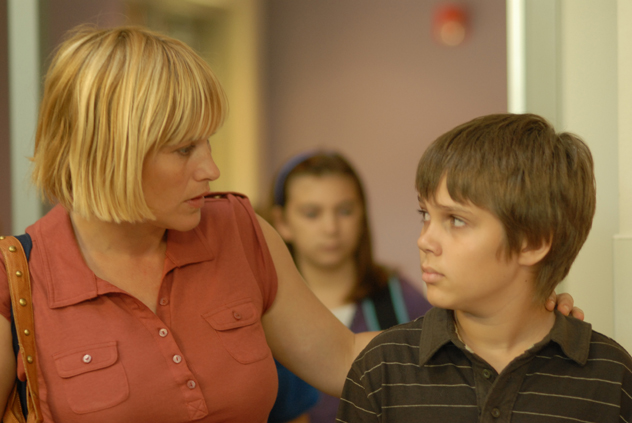
At times, his portrayal of child- and young adulthood almost feels hammy; you can’t be sure if this is how it really felt, or if you’re instead watching a semi-familiar life story shown through the rose-colored glasses of The Wonder Years. At which point you ask yourself whether Linklater has truly achieved something bold and original, or rather re-chartered territory that would be otherwise redundant if not for Mason Jr. and Samantha’s natural progression in age, because the internal and external voice of the film is one of sentimentality. The aim is to project experiences that we’ve all had while stimulating our minds with the realness of time; and in all fairness, Boyhood most certainly achieves that much.
But at the same time, this movie is two hours and 45 minutes long. There comes a point where the minutia of Mason’s late teens are somewhat superfluous, not to mention Coltrane’s seeming regression as an actor as he grows older. Or was it just that I didn’t particularly care for the teenager he became? That’s always a legitimate question: Was this character poorly acted, or was it simply portrayed too well as a person I didn’t really like? Which isn’t to say that 17-year-old Mason Jr. is lamentable, but rather that I prefer his defiant 10-year-old self to the I’m-so-misunderstood teen he eventually becomes.
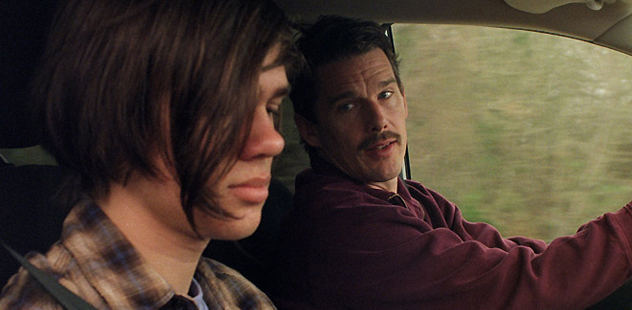
In some ways it isn’t altogether fair to focus solely on Mason Jr.—Patricia Arquette really does stand out with brilliant performance. Aside from still possessing a beauty that literally jumps out of the screen (be it scenes shot in ‘02 or ‘13), she’s got all the chops and more to showcase a loving, yet flawed mother perpetually struggling with the challenges of single motherhood. In some ways, Arquette is the star of the film, as the characters of both Coltrane and Lorelei are entirely centered around their interaction with mama bear. And moreover, her effectiveness as an actress is in no way whatsoever based upon her 12 years of aging—she’s just that good. I wouldn’t be the least bit surprised to see Arquette nominated for an Academy Award come Oscar season.
Despite my various misgivings and overly sentimental quandaries, Boyhood on the whole is a smash. Where it oversteps in duration, it resoundingly succeeds in general soul, even when staggering within the limitations of sap. This is a film you’ll be reminded of in the months ahead, and, perhaps for Linklater, his best chance at long-overdue national recognition.
Dawn of the Planet of the Apes
Rated PG-13 • {3 out of 5 stars}
I consider the original Planet of the Apes to be one of the greatest science fiction movies ever made. Charlton Heston rounding the corner and melting down at the vision of a washed up Statue of Liberty is in itself one of the more iconic moments in all of film, period. And oddly enough, for all the unnecessary, ridiculous and embarrassing rehashes churned out by the We Don’t Have Any Good New Ideas So Let’s Use an Old One Machine (aka contemporary blockbuster Hollywood), the Planet of the Apes franchise is in some ways bulletproof. This we owe to the ‘70s, as they saw fit to jump the shark on the Apes name long before jumping the shark was downright expected. Beneath the Planet of the Apes, Escape from the Planet of the Apes, Conquest of the Planet of the Apes, Battle for the Planet of the Apes—four awful sequels released in three short years between 1970 and ‘73. So despite whatever nefarious efforts modern producers and directors might enlist, they are powerless to piss on the franchise because it’s simply already been done. Which is why I can casually shrug at Tim Burton’s 2001 mockery of a reboot, and why I wasn’t appalled at yet another stab being made by Rupert Wyatt in 2011 with Rise of the Planet of the Apes.
Dawn of the Planet of the Apes is the latest chapter. Directed by Matt Reeves (Cloverfield), Dawn picks up 10 years down the line from Rise…. The world’s human population has been decimated by the simian virus unintentionally cooked up by San Francisco biotech company Gyn-Sys, with once-captive apes now thriving off their intelligence boom. Caesar, the ape responsible for empowering the primate breakout, is the established and respected leader of a contingent living in the Muir Woods. To the apes’ collective surprise, they one day happen upon a small group of humans looking to generate power from a deserted dam, leading to the apes’ realization that a very small community of homo sapiens is still alive in the city itself. Skeptical of their possible motives, and rightfully so, Caesar leads a force into San Francisco to divide the line between man and ape. But noble human Malcolm (Jason Clarke of Zero Dark Thirty fame) is able to negotiate a brief and unstable peace by assuring Caesar that electrical power is all they seek. But with a stockpile of human weaponry discovered by disgruntled rogue ape Koba, a Shakespearean drama begins to unfold whereupon Caesar meets an untimely demise (or does he?), igniting war between…man and ape.
Though I jest in tone, I’ll say right now that this is a movie worth seeing for sci-fi fans. While the plot is relatively predictable and the pace of the movie does drag, it’s not outrageously stupid and doesn’t shoot for the moon, nor should it. Because there is no wheel to reinvent here; it’s the eighth film in a 46-year-old franchise. So what really makes Dawn of the Planet of the Apes tick is outstanding special effects—these fuckin’ apes look (and sound) real. While I’ll always admire and prefer the costuming and makeup of 1968 Dr. Zaius, there’s something to be said for creating chimps, gorillas and orangutans so realistic you actually feel slightly anxious watching them attack on screen. Beyond the action, though, Dawn… makes a genuine effort to have the apes be the dramatic stars of the film; ape time far outweighs human time, with the apes themselves conveying a wide range of emotion in the process. You look at them like people, and that’s an accomplishment in not just effects, but in writing. Played so well is the humanistic angle, that I’d go as far as to echo the sentiments of a 13-year-old kid sitting next to me, when he coyly remarked, “Was I the only one rooting for the apes?” (The movie’s got some simian heart, is what I’m trying to say here.) And although it’s something of an aside, I would be remiss not to mention Gary Oldman. Yeah, he made a total fool of himself in the media recently, but the guy can flat-out act. His character, Dreyfus, who probably doesn’t occupy more than 15 total minutes of screen time, lends professionalism to the entire cast, similar to a musician being felt but not heard.
After 120-plus spins on your wristwatch, Dawn of the Planet of the Apes’ final scene ultimately paves an obvious road for the next installment, which, as one might expect, will be a battle royale between…man and ape. And I think I know who wins. The humans. Wait, no.
Rock ‘n’ roll Louisville descends upon the Witch Room
I remember what it was like to be 20. I didn’t have a clue. Not a fuckin’ clue. State college, you say? An institution of higher learning…yes, yes of course. I suppose I was making strides in the right direction, but for the most part I was a capricious idiot whose only real concern was attending just enough classes to float a 2.0 GPA. As for the songs I was writing at that age? Steaming piles of hot dog shit. I’m mortified beyond belief just thinking about them. So when I look at a band like White Reaper from the rarified air of Louisville, Kentucky, barely out of their teens and writing full-flight rock ‘n’ roll punk for Polyvinyl—I’m not only impressed, but humbled.
Tony Esposito plays guitar and sings. He’s one-third of White Reaper, whose take on punk rock spreads itself across the spectrum of noise pop while evoking distinct moods of the Ramones and Black Lips. The other two-thirds of White Reaper? Nick and Sam Wilkerson, who just happen to be twins.
“I met those two in fifth grade,” reminisces Esposito from his home in Louisville. “We started playing together when we were 13, 14; pretty much ripped off Minor Threat and were super into hardcore punk. I [had] played drums in a Christian church band for a while [laughs]. I definitely upgraded.”
It stands to reason that borderline pre-pubescent boys actively trying to mimic Minor Threat have at least a puncher’s chance in their musical future, and so it went. But to say that Louisville isn’t the first American city to come to mind when considering the rock ‘n’ roll landscape would be a massive understatement. In fact, call me ignorant, but up until two or so months ago when White Reaper appeared in my inbox, I’d never knowingly heard any band from Louisville, let alone one that lent itself to punk.
“In terms of the scene here, it really comes and goes. Before we had started playing shows, there wasn’t a whole lot going on, a drought of sorts,” he tells. “[But] there was never a point in time where we thought we couldn’t do it. No matter what the terrain was like. It’s really all we have; all we’ve ever had. We never really thought of doing anything else.”
Which is to our collective benefit. Because White Reaper’s six-song, self-titled debut has it going on, and then some. With production that’s both tinny and ballsy at the same time, “Cool” should be all a listener needs for an immediate and repetitive hook, as Esposito flits a descending howl into the gratifying simplicity of “She can’t even sleep at night!” Lather, rinse, repeat. Lather, rinse, repeat. And while the up-tempo, two-minute material is what initially leaps out of the speakers at you, a song like “Ohh (Yeah)” is evidence that the group is more than comfortable slipping into the mid, deviating from the more traditional punk panorama. Esposito explains…
“As much as we love punk rock, we’re sick of the word. I mean, that’s all anyone’s ever said to us. ‘Look at these punk kids! Look at these 14-year-old punk kids, man!’ And we’re kind of trying to be a little bit more than a punk band. Because I feel like the word ‘punk’ kind of cheapens the music, in a weird way. Not that I don’t absolutely love it, but I think it’s a lazy word. We just wanna play rock ‘n’ roll. That’s the main goal here. That’s what everyone wants, however we can do it.”
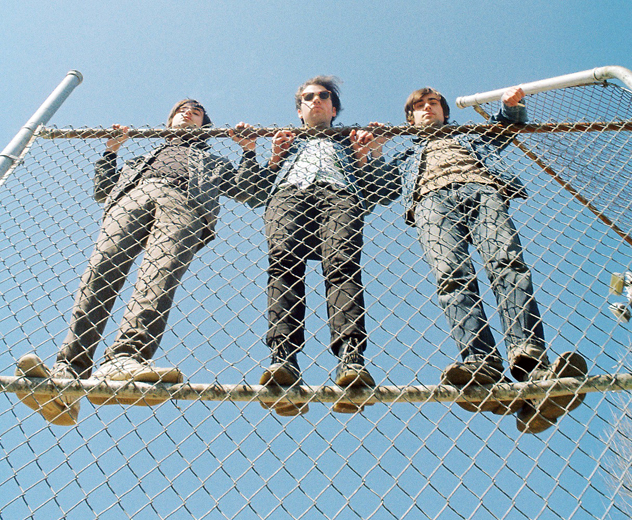
A telling amount of youthful optimism steps forth in the way Esposito makes such a statement, and at the risk of sounding nostalgic, I’ll say it’s refreshing. Because there’s a certain attitude that comes with musicians at such an age that simply can’t be replicated 10 years down the line.
Words like “naiveté” and “innocence” are off-point because they’re backhanded and smack of jadedness. It makes more sense to plainly recognize that White Reaper’s forthcoming national tour will be their first trek to the West Coast. Hell, Esposito has never personally traveled west of Texas. And at the age of 20, with Polyvinyl backing your kick-ass, yet-to-be-released EP, why wouldn’t you be excited for this first official stint on the road?
“The rush you get waking up on a different floor or a different couch in some dude’s house somewhere,” says Esposito with a mark of whimsy, “trying to find something to eat that’s not gonna kill you; trying to stay clean. A lot of people will say they’re afraid to tour because it’s not as glamorous as it may seem, but honestly it’s the coolest fucking thing there is, in my opinion. I’m really excited to see Denver. I’m excited to see California. I’m expecting to love it.”
None of this is to say, however, that White Reaper isn’t already a seasoned live band. The material on the EP was written well over a year ago, they practice every day, and have been playing in and around their home turf with frequency since inception. Which led me to the curiosity of what hot spots might be slipping under the radar of a West Coast mind; a good portion of, if not all of the South is often skipped on your average national tour. There are of course exceptions: Athens, Georgia; Asheville, North Carolina; Nashville; Atlanta, etc. But for the most part the South will not make up the meat and potatoes of most circuits, to which Esposito can attest.
“It’s a very weird part of the country,” he begins in a head-scratching tone. “Louisville’s fucking weird, man; Lexington—I think it’s the second biggest city in Kentucky—is also fucking weird. There’s not really a certain demographic. There’s a lot of small groups of people that are into a bunch of different shit. [But] speaking of Athens, Georgia—Athens, Ohio. We played a couple shows there, and they go fucking nuts during Halloween. There’s like five graveyards in that city that are fabled to make a pentagram shape.”
Perhaps as much as anything, White Reaper’s coming trek will benefit the trio by giving them a chance to break out of their daily routine. Having made music the A-number-1 priority in life, there seemingly isn’t a whole lot more Louisville has to offer them at this very moment. But you can bet touring the country with Young Widows under the guise of a hip label is going to offer them that much-needed change of pace and exposure.
“Oh man, I hope that we see significant changes,” says Esposito. “Not that we have super shitty lives right now—we’re just bored all the time. We don’t go to school, we don’t have jobs, we don’t do shit. We just get together every day and play music real quick. My mom teaches piano to little kids, so we gotta get in here around noon and then we just go through the set as many times as we can, as fast as we can. It’s so funny—there’s such a small window of time to practice, but then we have all this free time on our hands.”
I have a feeling, though, that things are indeed going to change for White Reaper. A band this good, this young, and motivated enough to make it via Louisville? They’re bound to make a push. So come to the show. Say you saw them the first time they came to California. I’ll be there. And I for one am glad that Sacramento is in on the ground floor.
See White Reaper live in Sacramento when they play Witch Room with Young Widows on June 26, 2014. The 18-and-over show is $10. For more info and for a full list of dates at Witch Room, go to Witchroomsac.com.
Captain America: The Winter Soldier
Rated PG-13 {1 / 5 stars}
Thursday night’s premier of Captain America: The Winter Soldier started out as something of a learning experience for yours truly. Opening the doors to the ticket lobby, I observed the surroundings and asked myself the following: “Why are there teenagers dressed up like superheroes? Why are there teenagers lining up two hours early for the midnight screening? And why are there only 25 seats left for the 10 PM?” Hey, I’m not naïve to the popularity, and I’ve seen many, many comic flicks over the last decade-plus. But I rent them. I watch HBO. I haven’t seen one in the theater since that first rancid Spider-Man came out, and it’s safe to say the experience has changed a bit. The only two-seat pairings available in the entire theater were in the very front row, in which I lasted one preview before abandoning ship for a single. “Don’t worry about it,” said my friend. “It’ll be like that episode of Coach…”
And here come the opening credits to hoots, hollers and applause. Why, it’s Chris Evans, the hunky hunk playing Steve Rogers cum Captain America. He looks good in that tight Under Armour shirt, running alongside Anthony Mackie, who’s welcomed into the Marvel film lexicon as Falcon. Then the sun shines, light humor is exchanged, and the audience bursts into guffaw. Anyway, unfrozen and still adjusting to modern society, Captain America is now a full-time agent of S.H.I.E.L.D., working closely with higher-ups Nick Fury (Samuel L. Jackson) and Alexander Pierce (Robert Redford). His super-female counterpart, fellow Avenger Black Widow (Scarlett Johansson), is rough-and-ready: game for action, espionage and giving a piece of her mind. But when an attempt is made on the life of Nick Fury by a silver-armed armed assassin known as the Winter Soldier, nothing is as it seems. S.H.I.E.L.D. is suddenly turned upside-down, finding Cap, Black Widow and the gang square in the crosshairs of a global HYDRA conspiracy. HYDRA’s mission? Launching a super-weapon set to eliminate 20 million undesirables around the world. It’s now up to the Captain and his crew to regain control before hope is lost…
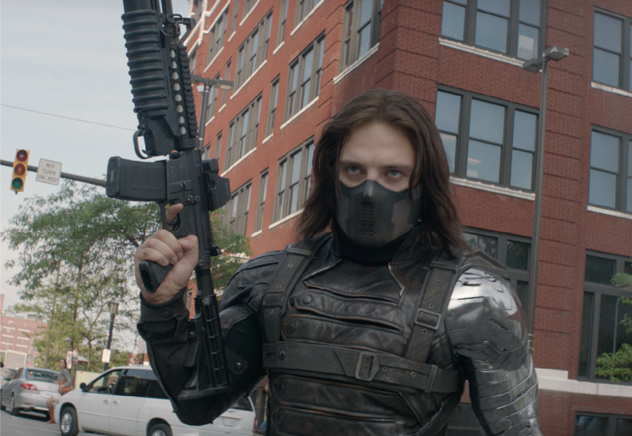
There’s a lot of moving parts to all that, though; cross-referencing threads from the first film (as well as The Avengers), character crossovers, deep wells of deception and suspicion, foreshadowing future installments…and none of it is interesting. Not even remotely. Tantamount to this intricate dullness would be the Winter Solider himself, for which the movie is given its namesake. Played by Sebastian Stan, the Winter Soldier reprises the character of Bucky Barnes, Steve Rogers’ army buddy from his time as a pre-Captain America pip squeak in the 1940s. Only now he’s a cryogenically revitalized killing machine, some sort of Nazi-Soviet-HYDRA experiment, not unlike the Captain himself. And yet the Winter Soldier is a feckless paperweight, arbitrarily inserted into action sequences while mixed up in a script that doesn’t seem to have any interest in his existence in the first place. And how’s this for a further summation: Chris Evans borderline stinks. Sam Jackson is inconsequential. Scarlett Johansson gets by on skill and beauty alone. Not even the action is worth a goddamn beyond basic technical merit.
Am I simply missing the hook on the continued success/barrage of Marvel-made movies? This fucking thing was 136 minutes of absolute filler. I’d like to say it’s because I grew up collecting Marvel and DC comics through the ‘80s and ‘90s, saving my money to buy collectibles from the ‘50s, ‘60s and ‘70s, that my standards for what these movies ought to be is just set too rigidly against the paperbacks themselves. But that’s not the case. I really like the Christopher Nolan Batman series. I genuinely dig a couple of the X-Men flicks. But this intertwined Avengers franchise, like so many other Marvel blockbusters of recent years, is weak-ass cheese. It’s Michael Bay bullshit filtered through the Marvel world. I don’t expect The Winter Soldier to be anything like Dolph Lundgren’s 89 in ‘89 Punisher, but 136 minutes? Really? Would the kids stop dressing up without Captain America’s Bill Pullman-esque speech to the S.H.I.E.L.D. masses? Would the dollar signs plummet if we turned the one-line-zinger knob down from 11? Would anyone get up and walk out of the theater without Garry Shandling’s second cameo as a taxidermied blowfish? Christ. I’m not gonna sit here and tell you Winter Soldier is as bad as Batman & Robin, but I’d much rather be entertained by relentless stupidity than bored out of my skull by cinematic Styrofoam.
300: Rise of an Empire
Rated R {3/5 stars}
Braveheart is the worst movie I ever once liked. It is positively unwatchable—an embarrassing spectacle of unconditional absurdity. In fact, here are three things I’d rather do right now than ever again watch Mel Gibson’s portrayal of William Wallace:
1. Drink Mongolian fire sauce on top of a burning anthill.
2. Buy a one-way ticket to the Crimea.
3. Wrap my mouth around an exhaust pipe and floor it.
Braveheart and the first 300 are third cousins; the latter seeming to me a waste of potential rather than a ludicrously acted and outright phony hagiography. 300 is beautifully crafted Frank Miller ultra-violence amid the backdrop of a Sin City-affected Spartan Greece, which unfortunately morphs into a toga party at the local Alpha Beta house. Granted nobody goes to an effects-driven Gerard Butler flick looking for Marlon Brando and the meaning of life, but acting and content have got to count for something. Needless to say my expectations weren’t sky-high going into 300: Rise of an Empire. But expectations are like assholes insofar as everybody’s got ‘em and they usually stink.
Directed by heretofore unknown Noam Murro, Rise of an Empire picks up where its predecessor left off: King Leonidas and his horde of 300 lay dead on the battlefield at the feet of Xerxes and the Persian army. Emboldened by his victory, Xerxes marches his throng toward Athens, which he is intent upon razing to the ground. Through the narration of Spartan Queen Gorgo (Lena Headey, Game of Thrones), we learn of Xerxes’ mystical transformation from ordinary man to God King. Revealed is how Themistokles (Sullivan Stapleton), one of Greece’s greatest warriors and admiral of the Athenian fleet, played an unforeseen role in Xerxes’ rise to power while defending the country from Persian invasion in a prior conflict. It is now the responsibility of Themistokles and his out-numbered navy to stave off Persia’s superior force while the cry for a united Greece rings out to each city-state.
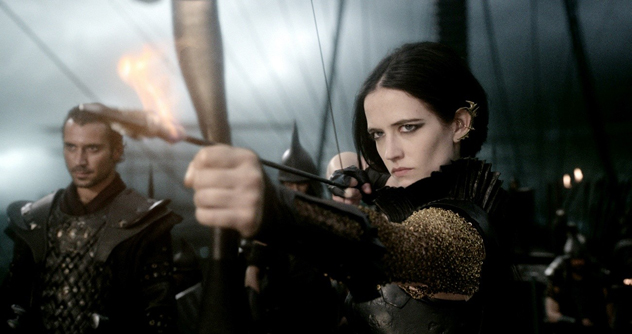
If you look at the nuts and bolts of that synopsis, it’s more or less the framework for any movie attempting to tell the tale of an epic Greek or Roman struggle, in that it’s sprawling and leaves much license for storytelling. The problem with movies like 300 is that they aren’t really trying to tell a story so much as they are looking for a vehicle to showcase action. Ultimately they get in their own way. But Rise of an Empire manages to avoid archetypal flaws, at least in the most sufferable ways, essentially clearing its own path. For example, Eva Green (Casino Royale, The Dreamers) plays Artemisia, ruthless queen of the Persian military and Xerxes’ closest personal ally. Greek-born but Persian-bred after being raped and pillaged by territorial Greek forces as a child, Green is convincing as a damaged, pitiless killer and adds a consistent female presence to a movie otherwise dominated by men. What’s more is Rise of an Empire’s slight dialing back on the William Wallace meter. Yeah, there’s some definite “but they will never take, OUR FREEDOM!” moments, but they’re a little less frequent, and when they do pop up, are somehow less abrasive and bro’d out.
This overall state of tolerability allows the viewer to focus on the one reason they came in the first place: Orchestral violence and gore. Say what you will about the merits of cinematic ultra-violence and its inevitable misuse, but Rise of an Empire is the Mozart of the genre. Set largely at sea aboard Greek triremes and the Persian equivalent, the famed slow-motion mayhem of the first film is only enhanced this go-round by the crashing black waves of the Aegean Sea and the mirror straits of Salamis. A visual delight of Greco morbidity replete with decapitations, severed limbs, slashed jugulars and everything else that can possibly be sliced, Rise of an Empire is immensely fulfilling as a purveyor of high camp brutality. Remember, though: This is not Hostel. This is something more parallel to an elegant vaudevillian riot, if one can imagine such a thing.
But all moderate praise aside, if you don’t like over-the-top senseless violence, you’re not going to like Rise of an Empire. Even if you do, you still might hate it. But if you liked 300, or even thought it had latent potential, you’ll probably really dig it. I hope that’s a reasonable conclusion. Because all I can think about right now is that scene in Braveheart where Mel Gibson shows everyone his taint.
The Lego Movie
Rated PG {4 out of 5 stars}
I played with Legos. Didn’t you? Asked for and got them on birthdays and Christmas; bought them with allowance money; raided them at latchkey when I was in second grade at Silverwood Elementary. You might say Legos were a formative aspect of my left-brain self, a reality I’m certainly not alone in sharing. But somewhere along the line I put them down, and at a point almost forgot they even existed. That is until about 10 years ago when all my little cousins started getting old enough to buy actual presents for, whereupon I realized that not only were Legos still in existence, but that they were as popular as they’d ever been, if not more so. Why not then, with their presence of utter ubiquity since the release of mini-figures in 1978, bring this acrylonitrile butadiene styrene wonder to the silver screen?
Warner Bros. has apparently been asking this same question since 2008, when The Lego Movie officially entered gestation. Over time, directors Phil Lord and Christopher Miller (Cloudy with a Chance of Meatballs) were selected to join writers Dan and Kevin Hageman (Hotel Transylvania). Perhaps most primary to the potential success of the film though was choosing Animal Logic (The Great Gatsby, Australia, Happy Feet) to head animation and visual effects. (Say what you will about the content of Animal Logic’s film credits; they’re all visually stunning, and that’s the business they’re in.) Now six years after its inception, the long-awaited final product is fortunately one worthy of standup applause.
The Lego Movie introduces you to Emmet (Chris Pratt), a happy-go-lucky construction worker with nary a thought in his head. Emmet’s favorite song is “Everything Is Awesome” by A Popular Band. His favorite television show is Where Are My Pants? And the most creative idea he ever had was to build a double-decker couch with cup-holders. He lives in a society consumed by homogeny, ruled by President/Lord Business (Will Ferrell). But upon demolishing a section of the city deemed incongruous, Emmit discovers a mysterious and beautiful woman, Wyldstyle (Elizabeth Banks), whom he unwittingly follows into the dark depths below. Long story short, Emmet comes into contact with The Piece of Resistance, and is decreed by the MasterBuilder Vitruvius (Morgan Freeman) to be “The Special,” who alone holds the power to save the world from Lord Business (if he can just evade Bad Cop, expertly voiced by Liam Neeson).
Ostensibly childish, the above plotline is actually rife with allegory from the outset, depicting a culture deprived of innovation and creativity. From its mainstream radio mockery of “Everything Is Awesome” to its throng of blue collar laborers following Lego instructions to a rigid tee, The Lego Movie’s aim for an overtly adult theme that children can still grasp is both fair and true. And with said adult theme comes surprisingly adept adult humor, considering the film’s PG rating. Yes, it would have been easy for the Hageman brothers to load the script with lame pop-culture references and bland fart jokes, but they instead craft a Lego Land that feeds off witty, fast-paced dialog, and yet they know how and when to pull back on the reins for effect. With cameos galore, viewers are treated to a variety of charming characters, including Batman (Will Arnett), 1980-something Space Guy (Charlie Day), Green Lantern (Jonah Hill) and Lando Calrissian (Billy Dee Williams!), to name just a few.
And oh that animation—you can practically feel the snap in your fingers. Animal Logic really nailed this one, masterfully creating one of those few flicks a year that’s an absolute must as a theatrical experience. The action is fast, furious and plentiful, with sets from the big city to the underworld, the Old West to Middle Zealand. What’s more are the many moments of sedation where it seems as if you could reach out and touch actual plastic. Basically, just sit back and enjoy 100 minutes of visual wizardry while the responsible parties buy polishes for their inevitable 2015 Oscar win.
And there you have it. An animated feature film marketed for children, written for adults, that ultimately pleases one and all. Easily the best movie of the New Year, expect to hear from The Lego Movie come award time next winter.
Out of the Furnace
Rated R
When I lay my head down on the pillow each night, there are only two things I wish for. The first is to meet and marry the woman of my dreams and have seven children that all grow up to be Olympians, senators, longshoremen, cattle rustlers, rum-runners, drag queens and Chamber of Commerce members. The second is more Woody Harrelson. Honest to Christ, is there a more underrated actor in all of Hollywood? I eagerly await the day True Detective debuts on HBO so I can get my weekly Woody. (Jesus did I say that? Or just think it?)
Director Scott Cooper must hold similar sentiments, as he opens his latest—the grey-skied Rust Belt drama Out of the Furnace—with the man of the hour front and center. Harrelson plays Harlan DeGroat, a savage, bare-knuckle kingpin of the New Jersey backwoods, and announces his presence at a drive-in movie theater with a classic villainous introduction that immediately forces the audience to hate everything about his very being (reminiscent of Denzel’s introductory scene at the diner in Training Day). We are quickly transported to North Braddock, Pennsylvania, a dreary steel town in Allegheny County where Russell Baze (Christian Bale) leads a typical, if not content, millworker’s life. He has a troubled G.I. brother up to his eyes in the wrong kind of debt (Casey Affleck), a girlfriend longing for pregnancy (Zoe Saldana) and a father dying of cancer, watched over by a loving uncle (Sam Shepard).
Russell looks out for his brother, Rodney, best he can, paying forward to John Petty (Willem Dafoe), the seedy but good-hearted bar owner/back-alley fight promoter that just can’t seem to get the prideful Rodney to take a dive for the sake of evening the score. But Russell’s world is turned upside-down when he careens his truck into the back of a station wagon while under the influence, killing a mother and child. He’s sent to prison, whereupon he misses the death of his father, in addition to his girlfriend leaving him for a local cop (Forest Whitaker).
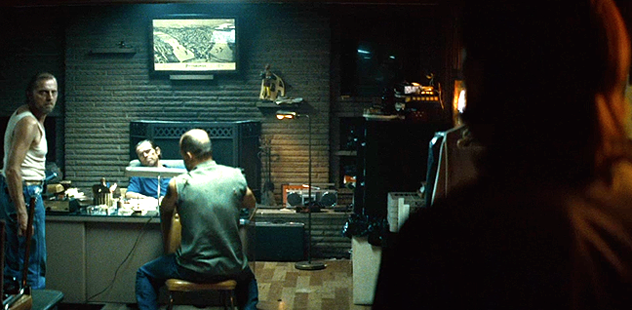
As you might have gleaned, Out of the Furnace is not a particularly uplifting film. It strives from the outset for a tone of drab melancholy, depicting bemused yet sympathetic characters. The plot is slow to materialize, which at times is frustrating, but the beautifully smoky and grim Rust Belt scenery often stands firm in the plot’s rightful place. Make no mistake, though; it is a misstep that by the time Russell is released from prison, a good portion of the film has passed and we’re still without any real notion of where anything is headed. But where Killing Me Softly and The Counselor fell flat on their faces in this same predicament, Out of the Furnace gets by with its utter lack of pretension. There is no attempt whatsoever at conveying any sort of pseudo-philosophical bullshit, nor is there anything slick or sleek about the characters themselves. They’re gritty and bare bones, which is to say there is not one instance of Brad Pitt eating a cheeseburger in a leather coat.
Eventually Rodney pushes John Petty against his better judgment and into booking him a fight in the Ramapo Mountains of Appalachian New Jersey, where our underutilized villain resides as king hillbilly. In what probably marks the zenith of the film via interpolation of brutal fist fighting and deer hunting, the trip proves disastrous just as foreseen, leaving both Petty and Rodney dead. Back home in North Braddock, the wheels of justice are seemingly slow to turn due to state lines and the backwoods secrecy of the Ramapo hill people. This leads Russell down the inevitable path of taking matters into his own hands, walking the viewers down a stretch of misguided and somewhat uninteresting cat and mouse play between him and DeGroat. We’re led to a climax that is something less than climatic, which, when considering the film’s general deliberation, is not altogether surprising.
When all is said and done, Out of the Furnace is a flawed success. A character-driven drama lacking in substance, superbly acted and gloriously shot amid some of America’s most unsung natural beauty. In looking to bookend this review with ruminations on Woody Harrelson (which might as well be applied to all thoughts in life), his sterling performance of Harlan DeGroat serves as a euphemism for pretty much the entire film in that it’s both brilliant and underdeveloped. Out of the Furnace will likely leave you with that feeling of a near miss, though sometimes being near is still close enough.
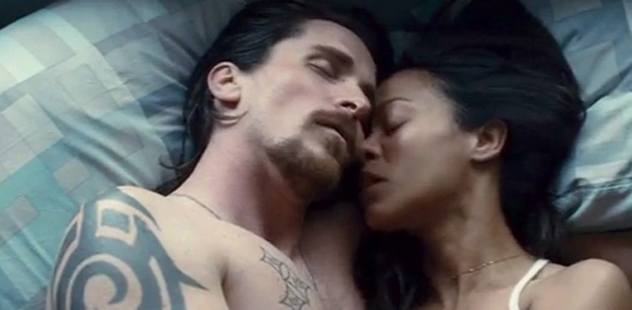
Counselor
Rated R
If it hasn’t happened already, someday one of your favorite actors or actresses will die. Be it old age, cancer, a tragic drug overdose or a plane crash, it obviously happens, and will happen again. You’ll be watching the Oscars, the Golden Globes or whatever, and there will inevitably be one of those “In Memoriam” segments that runs snippets of a person’s silver screen career. And you’ll recognize all the snippets, except for one, and you’ll say, “Damn, I can’t place what the hell that’s from.” Maybe you saw it and forgot it. Maybe you swore you would and never did. Maybe you picked the box up at All the Best Video 20 different times and carried it around the store for an hour only to put it back on the shelf at the very last second.
That’s The Counselor. Allow me to explain.
Directed by Ridley Scott (Alien, Prometheus), The Counselor is hard not to at least peek at through the corner of your eye—it rolls out an absolute A-list cast, star-studded to the gold fronts. Michael Fassbender (Inglourious Basterds) plays, well, “the counselor,” a cocky, nameless, quick-witted El Paso, Texas lawyer with a beautiful bride-to-be (Penelope Cruz), whom he enjoys performing oral sex upon. Driven by greed and an implied sense of invincibility, the counselor decides to try his hand at the drug trade, arranging the nuts and bolts of a major coke deal via Juarez and the Cartel. His associates are Reiner (Javier Bardem) and Westray (Brad Pitt), both of whom have deep Cartel connections, and both of whom sardonically advise the counselor not to take this irreversible step. Ominously watching from the sidelines is Malkina (Cameron Diaz), Bardem’s devilishly intelligent and underhanded lover. But the counselor, whom Fassbender cleverly portrays as the type of pretty boy know-it-all you’d love to see fail, fears not what he can’t understand and dives in head first.
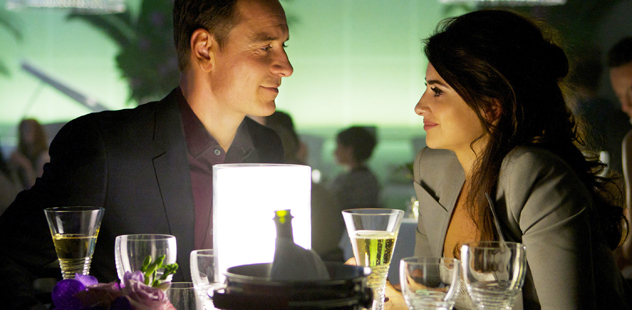
This plot comes screaming at you like the pulse of a comatose camel. Scott’s attention to cinematography and the film’s general slickness is not to go unnoticed, but what’s lost in the lavish setting of Bardem’s hillside mansion and Pitt’s custom cowboy suits is an overall sense of pacing. Scott, though, would most likely brush such a criticism aside, and point to the philosophic tone that abounds, a pacemaker by design. Written by renowned author Cormac McCarthy, each character in the film finds their own personal way to wax intellectual on the morality and life-death practicality of the various paths they’ve chosen. Mixed up in all this pseudo-intellectual morbidity is a strange and overt interplay of seething sexuality. Diaz—who now looks something akin to an alien from Communion—caps this theme late with a truly bizarre soliloquy on the carnal nature of her prize cheetah killing wild rabbits.
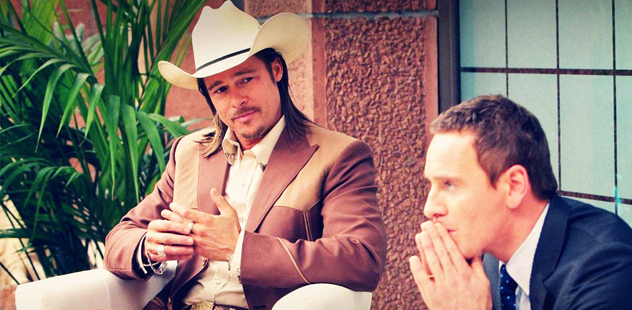
Scott eventually heats things up a bit, if only for a minute. The counselor’s drug deal goes horribly wrong from the inside out, leaving both him and his associates $20 million in debt to the Cartel. This spells ultimate doom for all parties involved, giving way to a series of brutal killings that in one instance even comes as a mild surprise, given the natural expectations of a formulaic Hollywood rescue mission. But just as things get interesting, you realize the movie is nearly done. One of those where you say something like, “Is this about to end? I think it’s ending. This is the end. It’s over.”
Of course I can’t say The Counselor is a total failure. It wasn’t painful to watch. Individually, there was plenty to grin about. Javier Bardem was brilliant, as always. Brad Pitt was sexy Brad Pitt, as always. There were notable and agreeable cameos (Dean Norris, Bruno Ganz, Rosie Perez, John Leguizamo, Natalie Dormer). Even Cameron Diaz, weird plastic surgery aside, was more than adequate. But none of these actors and actresses will be remembered for what they did in The Counselor. It was forgettable, elegant and profound as the intention may have been. Maybe it’s just that I have trouble relating to the philosophic ponderings of man accepting fate in the face of unfathomable adversity when coming from the perspective of wealthy, fashionable coke peddlers. Perhaps I simply can’t appreciate the plight. I’ve also never seen a leggy blonde achieve an orgasm on the windshield of a Ferrari before. Does that make you want to see The Counselor more, or less? I won’t judge you either way.


